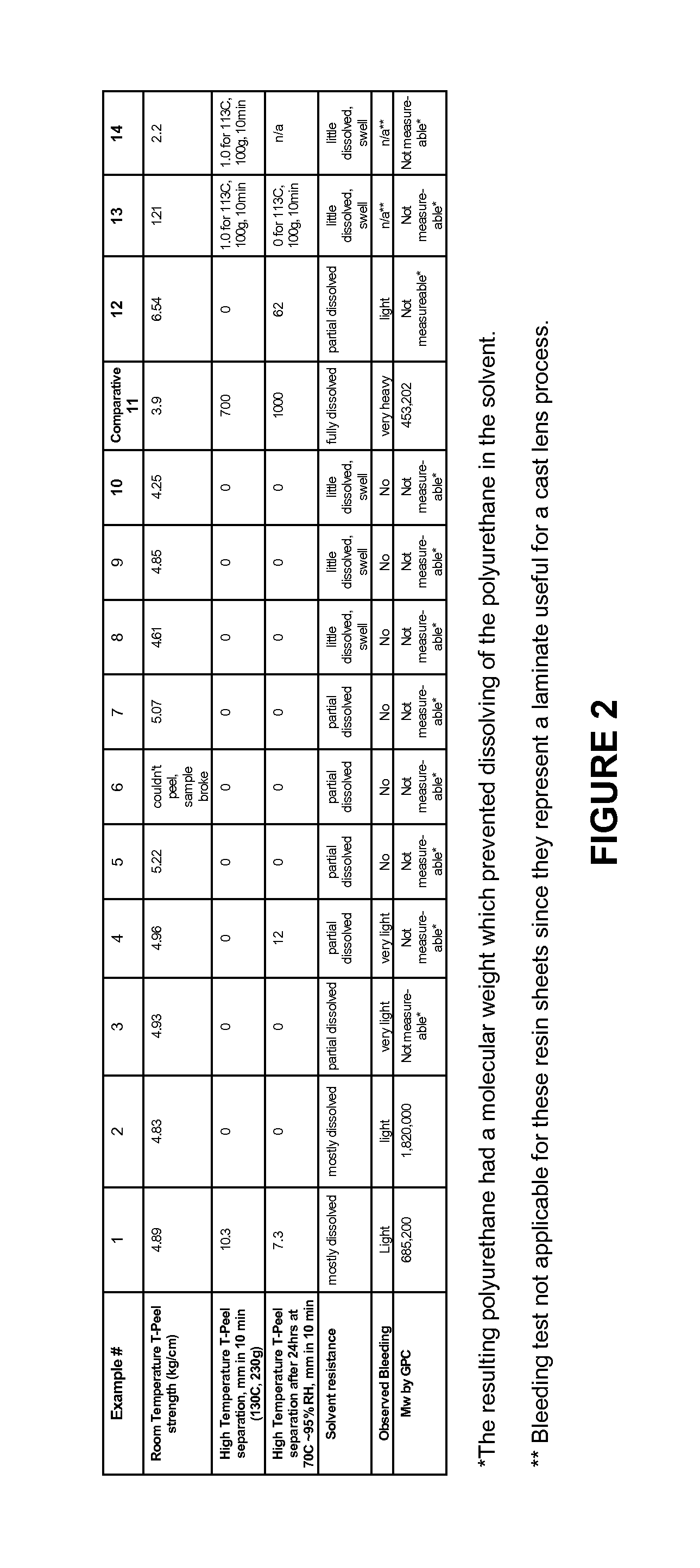Photochromic polyurethane laminate
a polyurethane and photochromic technology, applied in the field of photochromic laminates, can solve the problems of polyurethane bleeding, polycarbonate, and relatively thick coating, etc., and achieve the effects of improving chemical resistance, improving mechanical strength, and improving the properties of the layer
- Summary
- Abstract
- Description
- Claims
- Application Information
AI Technical Summary
Benefits of technology
Problems solved by technology
Method used
Image
Examples
synthesis example 1
Synthesis of Thermoplastic Polyurethane
[0029]Step 1: Synthesis of Isocyanate Prepolymer.
[0030]In a 3-necked flask equipped with an overhead stirrer, thermocouple, and a vacuum adapter, 1226.0 g (9.27 equivalents) of 4,4′-dicyclohexylmethanediisocyanate (H12MDI, available from Bayer as Desmodur W) was charged into the reactor and stirred at ambient temperature. 2000 g (4.02 equivalents) of a polycaprolactone diol having an OH number of 112 mg KOH / g and a number average molecular weight of about 1000 g / mole (available from Dow Chemical as Tone™ 2221) was preheated in an oven to 80° C. and added to the reactor. The mixture was allowed to stir for about 15 minutes, before adding 16 g of dibutyltin dilaurate catalyst (available from Air Products as T-12). The reaction flask was evacuated (<0.1 mm HG) and held at 90° C. for 6 hours. An aliquot of the prepolymer was withdrawn and titrated for isocyanate content using standard n-butyl amine titration. The isocyanate content was found to be ...
synthesis example 2
Synthesis of Isocyanate-Active Prepolymer
[0033]In a 3-necked flask equipped with an overhead stirrer, thermocouple, and a vacuum adapter, 1210 g (9.15 equivalents) of 4,4′-dicyclohexylmethanediisocyanate (H12MDI, available from Bayer as Desmodur W) was charged into the reactor and stirred at ambient temperature. 3000 g (6.03 equivalents) of a polycaprolactone diol having an OH number of 112 mg KOH / g and a number average molecular weight of about 1000 g / mole (available from Dow Chemical as Tone™ 2221) was preheated in an oven to 80° C. and added to the reactor. The mixture was allowed to stir for about 15 minutes, before adding 12 g of dibutyltin dilaurate catalyst (available from Air Products as T-12). The reaction flask was evacuated (<0.1 mm HG) and held at 90° C. for 6 hours. An aliquot of the prepolymer was withdrawn and titrated for isocyanate content using standard n-butyl amine titration. The isocyanate content was found to be 3.07% (theory; 3.10%). The polyurethane prepolyme...
synthesis example 3
Synthesis of Thermoplastic Polyurethane
[0034]595.5 g of isocyanate prepolymer prepared in step 1 of synthesis example 1 was heated in vacuum (<0.1 mm HG) with stirring to 80° C. and combined with 48.0 g of 1,4-butane-diol while stirring. The mixture was stirred for 30 seconds and subsequently poured into a Teflon lined tray. The tray containing the casting was cured in an oven at 85° C. for 24 hours. The thermoplastic polyurethane obtained had weight average molecular weight of 75,230 measured by GPC.
PUM
| Property | Measurement | Unit |
|---|---|---|
| thickness | aaaaa | aaaaa |
| temperature | aaaaa | aaaaa |
| weight | aaaaa | aaaaa |
Abstract
Description
Claims
Application Information
 Login to View More
Login to View More - R&D
- Intellectual Property
- Life Sciences
- Materials
- Tech Scout
- Unparalleled Data Quality
- Higher Quality Content
- 60% Fewer Hallucinations
Browse by: Latest US Patents, China's latest patents, Technical Efficacy Thesaurus, Application Domain, Technology Topic, Popular Technical Reports.
© 2025 PatSnap. All rights reserved.Legal|Privacy policy|Modern Slavery Act Transparency Statement|Sitemap|About US| Contact US: help@patsnap.com



